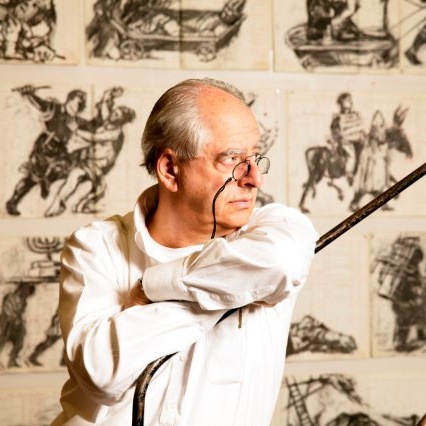
News

Kentridge reflects on those used by war
ROBYN SASSEN
It is upon the reflected thwarted hopes and broken dreams of these men that internationally-acclaimed artist William Kentridge has based his current exhibition in Johannesburg, titled KABOOM!
Over the years, Kentridge, who is unequivocally contemporary South Africa’s most well-respected and recognised artist, has always focused on the social realities that inform a war on a grand scale. Indeed, since the late 1980s, he has referred to the anti-war rhetoric of German artists Otto Dix and Max Beckmann, as well as something of the pro-war rhetoric that made the poetry of Italian futurists so mad and engaging. “Tatatatata!” it shouted, emulating the guns of war, with an absurdist voice that is destructive and seductive, yet speaks of the testosterone-infused enthusiasm of young men.
Having studied art through the Johannesburg Art Foundation, and performance through L’École Internationale de Théâtre Jacques Lecoq in Paris, Kentridge also played a seminal role in Johannesburg’s post-Soweto Riots Junction Avenue Theatre Company in the 1970s. He collaborated then with theatre luminaries like Malcolm Purkey, Pippa Stein, Patrick Shai, and Ramolao Makhene.
The son of South Africa’s most important legal family – his father, Sir Sydney, was leading defence lawyer in the Treason Trial, defending Nelson Mandela – William (born in 1955) effectively invented himself as an artist. He doggedly continued to work in the face of gallery rejections, until he began to be taken seriously by gallerists of the ilk of Linda Givon, the founder of the Goodman Gallery, in the 1980s.
Kentridge’s phenomenal work ethic and collaborative generosity has stood the test of time. At the moment, his Centre for the Less Good Idea, now in its fourth season at the Maboneng complex in downtown Johannesburg, has proved to be a remarkable incubator for all sorts of fabulous creative energy. This year’s season has seen important giving and taking between Kentridge and live performers, including composer Jill Richards, and jazz performer Kyle Shepherd, to name but a few.
But, if you watch the three-channel film central to KABOOM! at the Goodman Gallery, you will also be able to step into the energy of that collaborative spirit. He constructed this magnificent foray into the themes underpinning his work, from a paean to the porters, to a metaphorical dance, to a snippet of Fritz Kreisler. Kentridge has used the choreographic and performative skills of many practitioners, including Greg Maqoma, Mncedisi Shabangu, and the work of composer Philip Miller, who has worked with him for many years.
And, if you know or have been following Kentridge’s work for some years, you will recognise the charcoal drawing of the kind of waterfall-based landscape that made colonialist explorers so seduced by the beauty of Africa. But these are not just basic renditions of the landscape: they’re fraught with radar sight-lines and dangers.
The exhibition begins with a massive “KABOOM!” which will grab your attention. As the gallery’s press release explains, this exhibition draws from work produced for two recent projects Kentridge has staged: The Head & the Load, which premiered earlier this year at the London’s Tate Modern; and his 2017 production of Alban Berg’s opera Wozzeck.
But these works didn’t come out of isolation. Kentridge’s pieces, such as Ubu and the Truth Commission and Wozzeck on the Highveld were enormous critical successes. They played with the possibilities of conjoining European stories of war, greed and corruption with South African ones, as they gave puppetry from the Handspring Puppet Company, under Basil Jones and Adrian Kohler, important cultural currency.
Above all, when you approach Kentridge’s work, you realise two things: his unrelenting curiosity in exploring the possibilities of ideas and looking at the bits left off of grand projects; but also his humility in the face of the process and the work itself.
There’s a great deal of “what if?” happening in the processions which he creates, in his use of disused encyclopaedia pages as support for his drawings and prints. There are also bronze cast sculptures in this exhibition, all of which coalesce to the work’s central theme. And, it’s been a long time coming.
Indeed, the gallery argues that if you missed all the most recent exhibitions and performances Kentridge has mounted overseas this year and just come and see KABOOM!, you will garner a very fair understanding of the magnificence of his work, from both a physical aspect and an intellectual one.
For his design of the opera Wozzeck, the gallery explains, Kentridge worked with photographs which documented Flanders’ ravaged battle fields in the wake of World War I. Wozzeck, based on the eponymous story by German writer Georg Büchner, is about a soldier who is broken emotionally by war. It was made into an opera by Alban Berg in the early 20th century, and has inflamed Kentridge’s imagination for decades.
“Is it possible to tell a story without telling it through the story of one individual – the girl, the soldier, the hero – standing in for the whole war?” Kentridge ponders in the gallery’s press release. His is an understanding of history “as fragmented”. It is the bits and pieces that he puts together to help forge “a provisional understanding of the past”.
Indeed, Kentridge comments on the “many things not used at the edge of rehearsed productions. Many of the items called to be looked at again, to be brought back onto the stage”, and this in many ways encapsulates the thinking process of this artist, who has become the darling of the world’s most prestigious festivals, galleries and opera houses, including the Musée du Louvre, in Paris, La Scala in Milan, and the New York Metropolitan Opera.
- KABOOM!, at the Goodman Gallery in Oxford Road, Rosebank, runs until 10 November.




